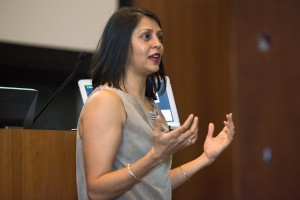 Award-winning science and health journalist Sonia Shah, the 2014 James H. Ottaway Sr. Visiting Professor of Journalism at New Paltz, gave a lecture on Tuesday, April 1 in the Coykendall Science Building auditorium about the prevalence of malaria since the beginning of mankind.
Award-winning science and health journalist Sonia Shah, the 2014 James H. Ottaway Sr. Visiting Professor of Journalism at New Paltz, gave a lecture on Tuesday, April 1 in the Coykendall Science Building auditorium about the prevalence of malaria since the beginning of mankind.
Shah, whose work has appeared in the Wall Street Journal, the New York Times and other publications, spent five years researching malaria to produce her latest book, “The Fever: How Malaria Has Ruled Humankind for 500,000 Years,” based on original reportage in Cameroon, Malawi, Panama, and elsewhere. Her TED Talk on the subject, “3 reasons we still haven’t gotten rid of malaria,” has been viewed more than 890,000 times.
Shah is the 13th endowed professor to join the New Paltz faculty for the Ottaway Seminar. Her course, “Science, Environment, and Disease: New Approaches to Science Journalism,” placed a special emphasis on the local issue of Lyme disease. But for Tuesday’s lecture, Shah’s focus was malaria.
Her interest in the disease goes back as far as her childhood, said Shah, when she would spend summers in India and was forced to sleep underneath a mosquito net. Her father would even chase her around the house pretending to be a giant mosquito.
“I was always the kid who was getting bitten by mosquitoes when everyone else was sort of unscathed,” said Shah. “Mosquitoes were just going crazy for me.” Contracting malaria from a mosquito was a much bigger risk for Shah than her Indian cousins, who had been exposed to the disease their entire lives and had built up immunity as a result. This is not uncommon in countries plagued by malaria, like Malawi, where Shah said a child may experience a dozen episodes of the disease by their second birthday.
Shah credited malaria, which got its name from the ancient Romans (mal aria is Italian for “bad air,” which was thought to be the source of the disease before the discovery that it was carried by mosquitoes), with being responsible for more than half of all human deaths since the Stone Age. To this day, she said, 300 million people are sickened with malaria every year, and 1 million of them will die from the disease.
“This disease is part of our ancestry,” said Shah. “I like to say we’re really a malaria species, because we’ve had it for so very long.”
Malaria’s continued pervasiveness in the modern world is puzzling, Shah said, since we’ve known how to cure it since the 1600s. Shah drew parallels between malaria and poverty, illustrated declining political interest in and funding for prevention, and perhaps most troubling, explained that “People who have malaria tend to care about it the least,” adding, “It’s like the cold and flu here (in the United States).”
In introducing Shah on Tuesday, SUNY New Paltz President Donald P. Christian called the Ottaway seminar “a very special program that’s a highlight for so many of our students during their studies here,” and quoted journalism student Katherine Speller as saying, “Getting the chance to sit across from the people who are performing our dream jobs is equal parts thrilling and daunting, exciting and intimidating, but it also gives us a chance to really soak up every little detail of their experiences.”
Shah’s lecture was followed by a reception and book signing.

